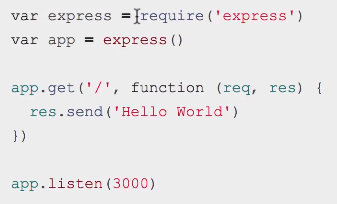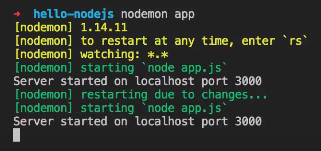[React] 05 - Route: connect with ExpressJS
基础:
初步理解:Node.js Express 框架
参见:[Node.js] 08 - Web Server and REST API
进阶:
Ref: 如何系统地学习 Express?【该网页有一些不错的资源】
express是一个基于node的web框架(集成web服务器+mvc),当然其实不用框架,使用node自己弄一个web服务器和mvc框架也不是很麻烦(Node为网络而生,当然强大的不止这点),但是有优秀的express,封装了很多常用功能,推荐用。
express主要依赖connect(基于node的http服务器框架,提供大量的中间件帮助用户构建强大灵活的web server),所以深入connect也是有必要的。
视频课程:Node.js + Express + MongoDB【中文版,有comment】from rails365编程学院
比较实用,简短,也是本篇的学习重点。
Several popular Node.js frameworks are built on Express:
- Feathers: Build prototypes in minutes and production ready real-time apps in days.
- ItemsAPI: Search backend for web and mobile applications built on Express and Elasticsearch.
- KeystoneJS: Website and API Application Framework / CMS with an auto-generated React.js Admin UI.
- Kraken: Secure and scalable layer that extends Express by providing structure and convention.
- LEAN-STACK: The Pure JavaScript Stack.
- LoopBack: Highly-extensible, open-source Node.js framework for quickly creating dynamic end-to-end REST APIs.
- MEAN: Opinionated fullstack JavaScript framework that simplifies and accelerates web application development.
- Sails: MVC framework for Node.js for building practical, production-ready apps.
- Bottr: Framework that simplifies building chatbot applications.
- Hydra-Express: Hydra-Express is a light-weight library which facilitates building Node.js Microservices using ExpressJS.
- Blueprint: Highly-configurable MVC framework for composing production-ready services from reusable components
- Locomotive: Powerful MVC web framework for Node.js from the maker of Passport.js
- graphql-yoga: Fully-featured, yet simple and lightweight GraphQL server
- Express Gateway: Fully-featured and extensible API Gateway using Express as foundation
磨刀不误砍柴工
第二次,则以轻松学 nodejs - 基础篇为底料,结合之前的学习,再屡一下思路:
[Node.js] 01 - How to learn node.js【1】
[Node.js] 02 - Read Eval Print Loop【2-】
* 命令行交互,子命令
* 新建进程 - child_process模块 ----> 详见 [Node.js] 06
* shell模式
[Node.js] 03 - Buffer, Stream and File IO【2-】
* Buffer类操作
* 文件操作 - 异步同步
* 文件流操作
* 管道操作
* os模块
[Node.js] 04 - Event and Callback【2+】
其实就是“监听器”:
* 回调函数,比如:异步读取文件的回调函数
* 观察者监视事件,
* 结合setTimeout构成“延时触发”,还有setInterval。
* 继承 EventEmitter
* Error 事件,遇到异常的时候通常会触发。
[Node.js] 05 - Modules and Function【2+】
* 常用模块
* 自定义模块
* 函数作为参数
* 全局对象:global 的属性,若干常用属性,console 方法。
* 常用工具 - util
[Node.js] 06 - Multi-thread and process module
* (略,另附专题)
[Node.js] 08 - Web Server and REST API
* Node.js RESTful API
* Node.js 路由,功能分离判断url
* GET / POST 请求上传表单
* 服务端如何response html? file? stream?
* Node.js Express 框架有什么不同和优势?这是本篇接下来打算详述的内容。
[Node.js] 09 - Connect with Database
- 其他:NPM, package json and nodemon
npm install express

npm install -g webpack
global:全局性的安装,以后可以直接使用webpack命令。
yarn是另一个较新的包管理器。
安装了什么包?通过package json来记录。
node_modules的内容很大,不是源码的一部分。
npm install // 安装dependencies中的包在node_modules中
npm install --save express
npm install --save-dev gulp
npm run start // 安装好了start中的内容,并修改相应的信息 in package.json.

dodemon,修改后自动更新网页,方便开发调试。
npm install -g nodemon,然后执行,开始自动监控所有文件的变化。

Nodejs + Express + MongoDB 基础篇
通过分装,相对于纯nodejs更有效率,表达更加简洁。
var express = require('express'); var app = express(); app.get('/', function(req, res) { res.send("this is the homepage"); // 分装了包的建立,所以便捷性 // 也可以发送其他类型:json,数组,对象等
}); app.listen(3000); console.log('listening to port 3000');
Express的路由比较强大!
- 路由支持正则表达式
var express = require('express'); var app = express(); app.get('/profile/:id/user/:name', function(req, res) { console.dir(req.params); res.send("You requested to see a profile with the name of " + req.params.name); });
// 支持正则表达式 app.get('/ab?cd', function(req, res) { res.send('/ab?cd'); }) app.listen(3000); console.log('listening to port 3000');
- 处理url中的参数
var express = require('express'); var app = express(); app.get('/', function(req, res) {
/* .dir 显示一个对象所有的属性和方法 */ console.dir(req.query); res.send("home page: " + req.query.find);
});
app.get('/profile/:id/user/:name', function(req, res) { console.dir(req.params); res.send("You requested to see a profile with the name of " + req.params.name); }); app.get('/ab?cd', function(req, res) { res.send('/ab?cd'); }) app.listen(3000); console.log('listening to port 3000');
- Post请求 - 表单上传
npm install body-parser --save
结合postman发送伪数据包来进行测试。
var express = require('express'); var bodyParser = require('body-parser') var app = express();
// create application/json parser var jsonParser = bodyParser.json() // create application/x-www-form-urlencoded parser var urlencodedParser = bodyParser.urlencoded({ extended: false }) // app.get('/', function(req, res) { console.dir(req.query); res.send("home page: " + req.query.find); }); app.post('/', urlencodedParser, function(req, res) { console.dir(req.body); res.send(req.body.name); });
------------------------------------------------------------------
app.post('/upload', jsonParser, function(req, res) { console.dir(req.body); res.send(req.body.name); }); app.get('/profile/:id/user/:name', function(req, res) { console.dir(req.params); res.send("You requested to see a profile with the name of " + req.params.name); }); app.get('/ab?cd', function(req, res) { res.send('/ab?cd'); }) app.listen(3000); console.log('listening to port 3000');
- Post请求 - 文件上传
参见:[Node.js] 08 - Web Server and REST API - Node.js Express 框架
* Switch请求各种资源
* 如果获得的是静态文件
* GET 方法
* POST 方法
* 文件上传
* Cookie 管理
推荐参考:Nodejs进阶:基于express+multer的文件上传
* 环境初始化
* 基础例子:单图上传
* 基础例子:多图上传
* 获取上传的图片的信息
* 自定义文件上传路径、名称
- EJS,一个模板引擎
(1) 原始方法,看上去复杂,因为竟然有两行,而不是一行。

(2) 可以直接使用sendFile。

(3) 继续添加变量。

npm install ejs --save
需要达到的效果:

Ref: 将模板引擎用于 Express【使用了 pug 例子,本篇则使用 EJS】
. / server.js
var express = require('express'); var bodyParser = require('body-parser'); var fs = require('fs'); var app = express(); app.set('view engine', 'ejs'); var multer = require('multer'); var createFolder = function(folder) { try { fs.accessSync(folder); } catch (e) { fs.mkdirSync(folder); } }; var uploadFolder = './upload/'; createFolder(uploadFolder); var storage = multer.diskStorage({ destination: function(req, file, cb) { cb(null, uploadFolder); }, filename: function(req, file, cb) { cb(null, file.originalname); } }); var upload = multer({ storage: storage }); // create application/json parser var jsonParser = bodyParser.json() // create application/x-www-form-urlencoded parser var urlencodedParser = bodyParser.urlencoded({ extended: false }) app.get('/', function(req, res) { console.dir(req.query); res.send("home page: " + req.query.find); });
-----------------------------------------------------------------------------------
模板引擎,在HTML中动态的嵌入变量
----------------------------------------------------------------------------------- app.get('/form/:name', function(req, res) { var person = req.params.name; res.render('form', { person: person }); // ----> });
可见,不用再写.html了,成了动态变量。
-----------------------------------------------------------------------------------
app.post('/', urlencodedParser, function(req, res) { console.dir(req.body); res.send(req.body.name); }); app.post('/upload', upload.single('logo'), function(req, res) { console.dir(req.file); res.send({ 'ret_code': 0 }); }); app.get('/profile/:id/user/:name', function(req, res) { console.dir(req.params); res.send("You requested to see a profile with the name of " + req.params.name); }); app.get('/ab?cd', function(req, res) { res.send('/ab?cd'); }) app.listen(3000); console.log('listening to port 3000');
. / views / form.ejs
<!DOCTYPE html>
<html lang="en">
<head>
<meta charset="UTF-8">
<meta name="viewport" content="width=device-width, initial-scale=1.0">
<meta http-equiv="X-UA-Compatible" content="ie=edge">
<title>Document</title>
</head>
<body>
<h1>
<%= person %>
</h1>
<form action="/upload" method="post" enctype="multipart/form-data">
<h2>单图上传</h2>
<input type="file" name="logo">
<input type="submit" value="提交">
</form>
</body>
</html>
Ref: Node.js + Express + MongoDB 基础篇 #8 使用模板引擎
server.js
var express = require('express'); var bodyParser = require('body-parser'); var fs = require('fs'); var app = express(); app.set('view engine', 'ejs'); var multer = require('multer'); var createFolder = function(folder) { try { fs.accessSync(folder); } catch (e) { fs.mkdirSync(folder); } }; var uploadFolder = './upload/'; createFolder(uploadFolder); var storage = multer.diskStorage({ destination: function(req, file, cb) { cb(null, uploadFolder); }, filename: function(req, file, cb) { cb(null, file.originalname); } }); var upload = multer({ storage: storage }); // create application/json parser var jsonParser = bodyParser.json() // create application/x-www-form-urlencoded parser var urlencodedParser = bodyParser.urlencoded({ extended: false }) app.get('/', function(req, res) { console.dir(req.query); res.send("home page: " + req.query.find); }); app.get('/form/:name', function(req, res) { var data = { age: 29, job: "programmer", hobbie: ['eating', 'fighting', 'fishing'] }; res.render('form', { data: data }); }); app.get('/about', function(req, res) { res.render('about'); }); app.post('/', urlencodedParser, function(req, res) { console.dir(req.body); res.send(req.body.name); }); app.post('/upload', upload.single('logo'), function(req, res) { console.dir(req.file); res.send({ 'ret_code': 0 }); }); app.get('/profile/:id/user/:name', function(req, res) { console.dir(req.params); res.send("You requested to see a profile with the name of " + req.params.name); }); app.get('/ab?cd', function(req, res) { res.send('/ab?cd'); }) app.listen(3000); console.log('listening to port 3000');
form.ejs
<!DOCTYPE html>
<html lang="en">
<head>
<meta charset="UTF-8">
<meta name="viewport" content="width=device-width, initial-scale=1.0">
<meta http-equiv="X-UA-Compatible" content="ie=edge">
<title>Document</title>
</head>
<body>
<%- include('partials/header.ejs') -%>
<h1>
<%= data.age %>
<h2>hobbie</h2>
<ul>
<% data.hobbie.forEach(function(item) { %>
<li>
<%= item %>
</li>
<% }) %>
</ul>
</h1>
<form action="/upload" method="post" enctype="multipart/form-data">
<h2>单图上传</h2>
<input type="file" name="logo">
<input type="submit" value="提交">
</form>
</body>
</html>
about.ejs
<!DOCTYPE html>
<html lang="en">
<head>
<meta charset="UTF-8">
<meta name="viewport" content="width=device-width, initial-scale=1.0">
<meta http-equiv="X-UA-Compatible" content="ie=edge">
<title>Document</title>
</head>
<body>
<%- include('partials/header.ejs') -%>
<p>about page</p>
</body>
</html>
header.ejs
<nav>
<ul>
<li><a href="">home</a></li>
<li><a href="">about</a></li>
</ul>
</nav>
Unfinished...





